Ranks and rank insignia of the Red Army 1918–1935
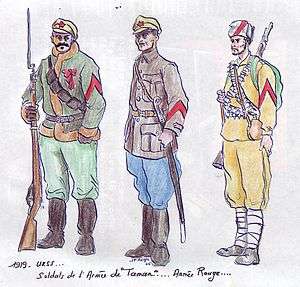
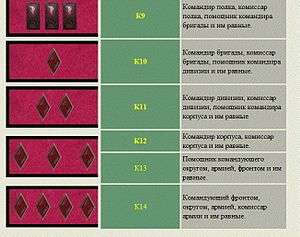
In the period from 1918 to 1935 of the young Soviet Union any bourgeois military thoughts were put under general suspicion by the communists, the new political establishment. Among other the Old Russian tradition, to wear epaulets and shoulder straps as rank insignia was rigorous abolished and were replaced with a new tradition of rank designations and insignia for the new Red Army and the nascent Soviet Navy.
First rank insignia
In the early period of the October revolution new uniforms were used and new units structured on the basis of the former Imperial Russian Army and Navy. The levelling of military grades and neglecting of rank designation were symptomatic of the new order. The first common rank designation throughout the Red Army was “Red Army man” (Russian: kрасноармеец; krasnoarmyeets) or, in the Workers' and Peasants' Red Navy, "Red Fleet man" (Russian: kраснофлотец; krasnoflotets).
Personnel designated to command a military unit were unofficially named "red commander" (Russian: красный командир; krasnyi komandir, abbreviated краском; kraskom). Commanders of major units (army or corps sized) were designated "army commander" (Russian: командующий армией; komanduyushchy armyye; abbreviated командарм; komandarm). For more detailed graduation komandarm I and komandarm II were adopted.
Commanding officers of major units below army and corps level were known as:
- Commander of a division: komdiv (Russian:комдив)
- Commander of a brigade: kombrig (Russian:комбриг)
In the navy from December 1917 until 1918, naval officers of the Imperial Russian Navy who joined its ranks were addressed by their tsarist rank with the addition of front abbreviation "b.", which meant "former", while new officers had to wait till 1924 for their rank designations to be issued.
With no formal Red Army insignia designated, red bows, cap peaks, sleeve patches and the red soviet star were worn, first by the so-called Red Guard units, later by all other Red Army units. In 1920 all the ranks and rank insignia of the Red Army and Navy were regulated by the orders of the Defence Commissar, Leon Trotsky.
Red star
The first official emblem of the Red Army was a chest badge (red textile bend and oak leaves twig, in the middle a star with sickle and hammer), introduced in April 1918. From summer of the same year the cap cockade, in form of a five-pointed star with hammer and sickle, was designated. At first two of the points were uppermost, before it was directed that a single point of the star should face the 12 o'clock position.
By orders number 953[1] and 1691[2] of the Revolutionary Military Council of the Red Army on structure and design of the cap cockade in shape of a red star, the official design was introduced for use by all personnel of the Red Army.
| Designation | Chest badge & cap cockade of the Red Army in 1922 | |||
|---|---|---|---|---|
 |
 |
 |
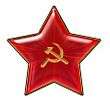 |
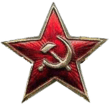 |
| Designation | Chest badge, Soviet star (with plug & hammer in the center) |
Star-cockade cap |
Badge as to Order № 953 (from April 13, 1922) |
Badge as to Order № 1691 (from July 11, 1922) |
Distinction insignia, ranks and uniform (ground forces)
By order from April 25, 1918 of the “People's Commissar for Military and Naval Affairs” a temporary committee was established, to develop proposals pertaining to the uniform of the Red Guards.[3] In November 29, 1918 the All-Russian Central Executive Committee approved these proposals and agreed to the rank designations as follows to be used, by both the Red Guards and the Red Army's ground forces as a whole:[4]
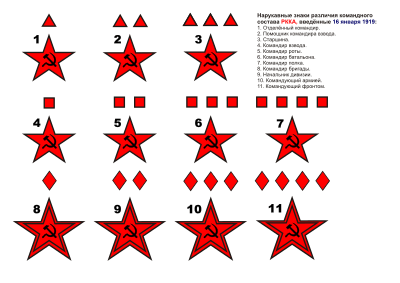
- Red army soldier (original designation: Krasnoarmeez)
- Squad leader (Komandir otdeleniya – short: Komot/ Otdeljonnyi komandir [picture 1])
- Assistant platoon leader (Pomoshtchnik komandir svoda – short: Pomkomwswoda [pic. 2])
- Company sergeant (Starshina roty), Battery sergeant (Starshina baterei), below squadron sergeant (Starshina eskatrony) or Sotni (picture 3)
- Platoon leader (Komandir vsvoda – short: Komvsvoda [pict. 4])
- Assistant company comannder (Pomoshtchnik komandir roty – short: Pomkomroty), Assistant squadron commander (Pomoshtnchik komandir eskatrony – short: Pomkomesk) first of all as assignment only
- Company commander (Komandir roty – short: Komroty), Squadron commander (Komandir eskatrony – short: Komesk [pict. 5])
- Assistant battalion commander (Pomoshtchnik komadir bataljona – short: Pomkombat) first of all as assignment only
- Battalion commander (Komandir bataljona – short: Kombat [pict. 6])
- Regimental commander (Komandir polka – short: Kompolka [pict. 7])
- Brigade commander (Komandir brigady – short: Kombrig [pict. 8])
- Division chief (Nachalnik divisiy – short: Natschdiw [pict. 9])
- Corps commander (Komandir korpusa – short: Komkor) first of all as assignment only
- Army commander (Komanduyushtchi armiy – short: Komdarm [pict. 10])
- Front commander (Komanduyushtchi fronta – short: Komfronta [pict. 11])
In December 18, 1918, the “Revolutionary Military Committee” agreed upon the new uniforms proposed. Among other three versions of caps and various rank insignia were adopted, in order to emphasize several appointments. It was followed by the official approval by order number 116 of the “Revolutionary Military Committee” from January 16, 1919 (see pictures 1 to 11). The ground forces of the Red Army and the nascent Soviet Air Force used these ranks until 1924.
Distinction insignia, ranks, ratings and uniform (naval forces)
With the definite beginning of the rehabilitation of the Soviet Navy in 1923-24 came the introduction of rank appointments for ratings and officers of the Navy. These ranks, however, began to be used during the Civil War years and were sanctioned in 1921.
- Red Fleetman (original designation: Krasnoflotez)
- Boatswain/Starshina (Botsman/Starshina)
- Squad leader (Komandir otdeleniya – short: Komot/ Otdeljonnyj komandir)
- Group commander (Komandir gruppy – short: Komgrup)
- Combatant Commander (Komandir boyevoy chast - Kombocha)
- Assistant Ship Commander (Pomoshchnik komandira korablya - Pomkomkor)
- Senior assistant ship commander (Starshy pomoshchnik komandira korablya - Stapomkomkor)
- Ship Commander (Komandir korablya - Komkor)
- Naval Battalion Commander (Komandir diviziona korabley - Komdivzkor)
- Naval Brigade commander (Komandir brigady korabley - Kombrikor)
- Naval Division chief (Nachalnik divisiy korabley – short: Nachdivkor)
- Chief of Naval Forces of the USSR (Nachalnik morskoi sily SSSR - Nachmorsi SSSR)
Uniform insignia followed the traditions of the Imperial Navy but with sleeve insignia for officers and all ratings, but the uniform itself remained the same as its Imperial Russian predecessors.
Distinction insignia and ranks 1924–1935
The following ranks were used by the Soviet military from 1924 to 1935. The new ranks came as a result of new People's Commisariat for Defense regulations concerning military ranks and appointments.
| Rank group leading personnel |
NATO equi- valent |
Natio- nal cate- gory |
Designation of the assignmant in the ... | Collar badge Army and Air Force |
Sleeve insignia Navy | ||
|---|---|---|---|---|---|---|---|
| ... Army (as to order of the RMC USSR № 807 from June 20, 1924) |
... Air Force | ... Navy | |||||
| No (enlisted men) |
OR1[5] | No (0) |
Red army man (Красноармеец, Krasnoarmeyets) |
Red air fleetman (Красновоздухоплаватель, Krasnoboedukhoplavately) | Red fleet man (Краснофлотец, Krasnoflotets) |
||
| Junior (level) | OR5 | 1 | Detachment leader | Junior engine-man (Младший моторист, Mladshy motorist) |
Squad leader (Командир группы, Komandir gruppy) |
 |
|
| Assistant subunit leader (Помощник командира отделения, Pomoshchnik komandir otdeleniya) | |||||||
| Subunit leader (below platoon level) | |||||||
| OR6 | Assistant platoon leader | Junior engine-man | Leader sub area, botsman | | |||
| OR7 | 2 | Starshina | Engine-man | Deputy leader combat area, Senior botsman | | | |
| OR8 | Platoon starshina | Senior engine-man | Senior sergeant combat area, Senior petty officer | | | ||
| Medium (level) | OF-1[6] | 3 | Platoon leader | | |||
| 4 | Assistant company leader, – battery, – squadron Self-contained platoon leader | Junior pilot | Assistant watch officer | | |||
| 5 | Chef or commissar - company, – battery, – squadron | Air Detail commander | Ship commander class 4, Senior assistant ship commander class 3 and equal in rank | ||||
| OF2 | 6 | Assistant battalion commander Deputy battalion commissar Commander self-contained company | Air Flight commander | Ship commander class 3, Senior assistant ship commander class 2 and equivalents | |||
| Higher career | OF3 | 7 | Battalion commander, or Battalion commissar | Air squadron commander | Ship commander 2nd rank | | |
| OF4 | 8 | Assistant regimental commander Commander self-contained battalion | Commander self-contained flying (battalion sized) unit | Senior assistant ship commander 1st rank and equivalents/small> | | ||
| OF5 | 9 | Regimental commander | Air Park Commander | Ship commander 1st rank and equivalents | | ||
| Top career | OF6 | 10 | Brigade commander Assistant to the Division Commander | Air Regiment Commander | Naval/Ship Brigade Commander | | |
| OF7 | 11 | Divisional Commander | Air Brigade Commander | Squadron Commander | | | |
| OF8 | 12 | Army Corps Commander Assistant Army Commander and equivalents | No equivalent | Flotilla Commander | | | |
| 13 | Assistant commander in chief of the military district | Assistant commander in chief of the Air Force of the Red Army | Commander of the Navy, Commander in chief of the USSR Naval forces | | |||
| OF9 | 14 | Commander in chief military district, – Army or – Front Member Revolutionary Military Council district | Commander in chief of the Air Forces of the Red Army | No equivalent | | No equivalent | |
The rank of Marshal of the Soviet Union, created on September 1935, took first precedence over all ranks since then. With the new Marshal rank being introduced, the Council of People's Commissars began the process of phrasing out the 1924 rank system.
See also
- History of Russian military ranks
- Ranks and rank insignia of the Russian armed forces until 1917
- Ranks and rank insignia of the Red Army 1935–1940 and ... 1940–1943
- Ranks and rank insignia of the Soviet Armed Forces 1943–1955 and ... 1955–1991
- Ranks and rank insignia of the Russian Federation´s armed forces 1994–2010
- Army ranks and insignia of the Russian Federation
- Naval ranks and insignia of the Russian Federation
References
- ↑ Order number 953 of the Revolutionary Military Council of the Red Army from April 13, 1922 on structure and design of the “Workers' and Peasants' Red Army” cap cockade.
- ↑ Order number 1691 of the Revolutionary Military Council of the Red Army from July 11, 1922 on structure and design of the “Workers' and Peasants' Red Army” cap cockade.
- ↑ Order from April 25, 1918 of the “People's Commissar for Military and Naval Affairs” on development of uniforms, to be worn by the Red Guards.
- ↑ Decision of the “All-Russian Central Executive Committee” from November 29, 1918 on uniforms and rank designations of the so-called Red Guards.
- ↑ The NATO abbreviation "OR" stands for "other ranks"
- ↑ The NATO abbreviation "OF" stands for de: "officer"